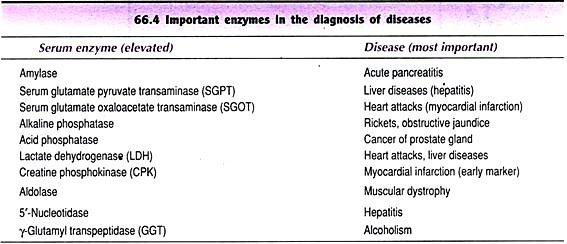Read this article to learn about the use of enzymes in the diagnosis of diseases.
Estimation of enzyme activities in biological fluids (particularly plasma/serum) is of great clinical importance.
Enzymes in the circulation are divided into two groups:
1. Plasma specific or plasma functional enzymes:
Certain enzymes are normally present in the plasma and they have specific functions to perform. Generally, these enzyme activities are higher in plasma than in the tissues. They are mostly synthesized in the liver and enter the circulation e.g. lipoprotein lipase, plasmin, thrombin, choline esterase, ceruloplasmin etc. Impairment in liver function or genetic disorders often leads to a fall in the activities of plasma functional enzymes e.g. deficiency of ceruloplasmin in Wilson’s disease.
2. Non-plasma specific or plasma nonfunctional enzymes:
These enzymes are either totally absent or present at a low concentration in plasma compared to their levels found in the tissues. The digestive enzymes of the gastrointestinal tract (e.g. amylase, pepsin, trypsin, lipase etc.) present in the plasma are known as secretory enzymes.
All the other plasma enzymes associated with metabolism of the cell are collectively referred to as constitutive enzymes (e.g. lactate dehydrogenase, transaminases, acid and alkaline phosphatases, creatine phosphokinase). Estimation of the activities of non-plasma specific enzymes is very important for the diagnosis and prognosis of several diseases.
A summary of the important enzymes useful for the diagnosis of specific diseases is given in Table 66.4.
